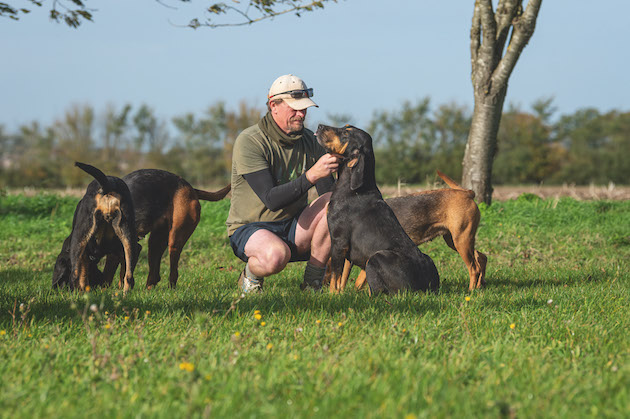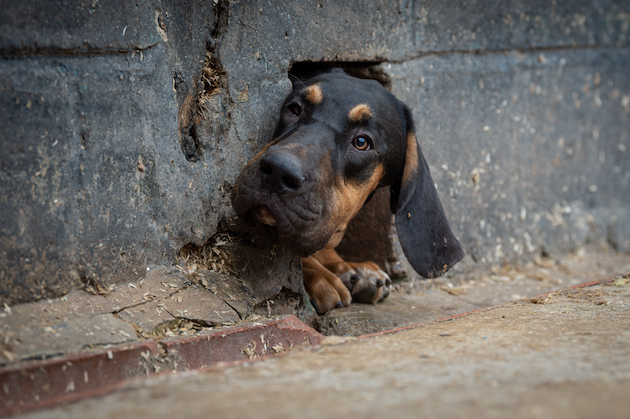What’s it like being hunted by a bloodhound?
How does it feel to be the hunted, rather than the hunter? Richard Negus takes to his heels in front of bloodhounds to find out

Richard Negus is caught by the happily friendly bloodhounds
I have lost count of the times random and faceless animal rights devotees have, on social media, offered a challenge for me to “get shot at and see how I like it” or “imagine I was the one being chased by a pack of ‘dogs’ for miles across country”. To the annoyance of the keyboard warriors I can truthfully reply that I have already been “shot at” with lethal intent, or more precisely, “mortared over”.
Thankfully the IRA’s marksmanship was off and I live to testify that my experience is much like that of a missed pheasant — a big bang then it was over with so quickly that I had no idea it happened at all. I had, however, never been hunted, other than games of hide and seek with Mabel. Therefore it was with a glad and grateful heart that I accepted the invitation from James Chadwick, Joint Master of the Hamilton Bloodhounds, to find out what is like to become the quarry.

James Chadwick is Joint Master and huntsman of the Hamilton Bloodhounds
Being hunted by a bloodhound
James is a remarkable young man. He hunts hounds and is his own kennelman. His partner Tegen acts as groom and whips-in. Theirs is a seven-days-a-week, 365 days a year role and they clearly love this life, this job and the 15 and a half couple of hounds in kennels. The hunt itself is similarly youthful, having only been formed in 2019. Hounds are kennelled at Easton, a picturesque village near Framlingham, the castellated town famed as the home of Suffolk’s greatest global export, Ed Sheeran. The thatched huntsman’s house and mellow red brick buildings were formerly the home of the fine old pack the Easton Harriers.
The decision to draft the harriers and replace them with bloodhounds was an undertaking both brave and controversial. Controversial, because tradition dies hard here in Suffolk. Brave in that, by disbanding the harriers they removed a part of the village’s DNA, as integral as Easton’s other famous landmark — the crinkle-crankle wall. A crinkle-crankle wall is a regional eccentricity with a purpose. Built in a serpentine wavy line of bricks, it is remarkably stable compared with a straight line. This particular wall is all that remains of Easton Hall, the now demolished seat of the Duke of Hamilton.

A bloodhound puppy poking out of a hole in the kennel wall.
Remorseless
Against this backdrop of heritage and history, James, joint Masters Lydia Freeman and Clare Simper and the hunt committee had some stark choices to make. It was becoming obvious that trail hunting in such a heavily hare-populated part of the country was near impossible. The hunt saboteurs knew too and carried out a remorseless campaign. Field sizes dwindled, parents were reluctant to let their children attend meets where balaclava-wearing vigilantes would habitually skulk behind every tree armed with electronic gizmos, cameras and spite. Landowners too became uncomfortable with the black-clad entourage. Subscriptions fell, country became closed and the harassment received by hunt staff insufferable. The choice therefore was either to disband and sell the kennels or do something revolutionary and keep on hunting. Thankfully these sporting East Anglians chose the latter and the Hamilton Bloodhounds were formed.
The hunting bloodhound is not the lumbering, intellectually challenged beast you associate with television adverts from the 1970s featuring Clement Freud and a slavering companion flogging dog food. They are long on the leg, rangy and athletic animals. The hounds currently hunting are drafts from other packs. But I met the home-bred young entry and if they hunt as well next season as they look, they’ll be marvels.
On the day I joined the Hamilton, they met at the achingly beautiful Crow’s Hall outside Debenham, a village known to fans of the TV series Lovejoy. The hall suited bloodhounds, as they are akin to the stately Talbot hounds that would have hunted these parts when this Tudor moated house was a new build.

The ‘clean boot/ runners ahead of the hounds
I joined my four fellow runners, who were to be the quarry being hunted by a bloodhound, in the back of the hound van to meet our canine nemeses. This is an important part of hunting the ‘clean boot’. The hounds need to get to know intimately, in an olfactory sense, the people they are going to hunt. I wore a T-shirt that had served me as a vest all week. Hedge laying is a somewhat sweaty business and one beautiful bitch called Playful seemed to particularly appreciate the extra musk of Negus. She hugged me like a long-lost lover and boldly stared me in the eye, as much to say “I’ll be seeing you later, fatty”.
After a sufficient time spent in getting sniffed, we jumped out of the van, bid our farewells to the field and started to run. I am a cross-country ultra-marathon runner, or rather I was a cross-country ultra-marathon runner. I haven’t run a yard for two years and when you are being hunted you cannot slack the pace. Richard, the regular lead quarry runner for the Hamilton, is built like a coursing whippet, as are his fellows. Our route was well planned by James as he laid on the hounds.

James Chadwick and the Hamilton Bloodhounds follow the quarry
In a season or two, the young huntsman wants to give the runners a freer rein to plot their own way on a run, providing a greater challenge to both the hounds and his own venery. At the moment these are fledgling days with his pack and he wisely wants to get to know how they hunt.
Our run was over 3.5km of arable country — headlands, stubble and plough. We had a 20-minute start on the hounds yet it seemed like seconds before the cry of the pack could be heard growing louder behind us. Taking a grateful rest from slogging up a sodden grass margin, we turned to watch the hounds hunting our line. They stuck to it like Velcro, following every curlicue we ran. On we went again and on came the hounds, as James viewed us he blew his horn and I felt a thrill.
Being hunted is a strange experience for humans. Like a fox, mink, hare or stag, we all understand that living is preferable to dying. However, unlike these animals we can envisage death in peculiar detail rather than simply fearing it in a general way. Therefore when I turned to look over my shoulder to see Playful charging towards me along with the rest of the joyful pack, though I had a fairly strong hunch she wasn’t going to chop the back of my neck, my human mind envisaged a bloody death that no furred quarry would ever do.
When Playful and the rest of the pack ‘caught’ us and we sweating, puffing runners were brought to bay, all I received was another hug from her. Bloodhounds are the most friendly of creatures and they appreciated the biscuits and liver they were offered as reward for their efforts in catching us.
After a pause, the runners headed off for the second and final run of the day. They went without me; I used the excuse of journalistic duties rather than letting on I was still puffed.
Spiteful
It is pointless to debate the fatuousness of the 2004 Hunting Act; anyone with a modicum of intelligence can see it was a piece of bad and spiteful law. Hunts that have continued to trail hunt have done so with mixed results. Some argued that with the Easton Harriers closing and the bloodhounds forming in their place, the antis had somehow ‘won’. I share the view of hunt chairman Nick Dowding, who said: “Disbanding would have meant we stopped hunting. But we are still going out on horseback following hounds across the beautiful Suffolk countryside and we are more popular than ever.”
The Hamilton could be a metaphor for fieldsports in the 21st century. “Tradition is not the worship of ashes, but the preservation of fire.”








